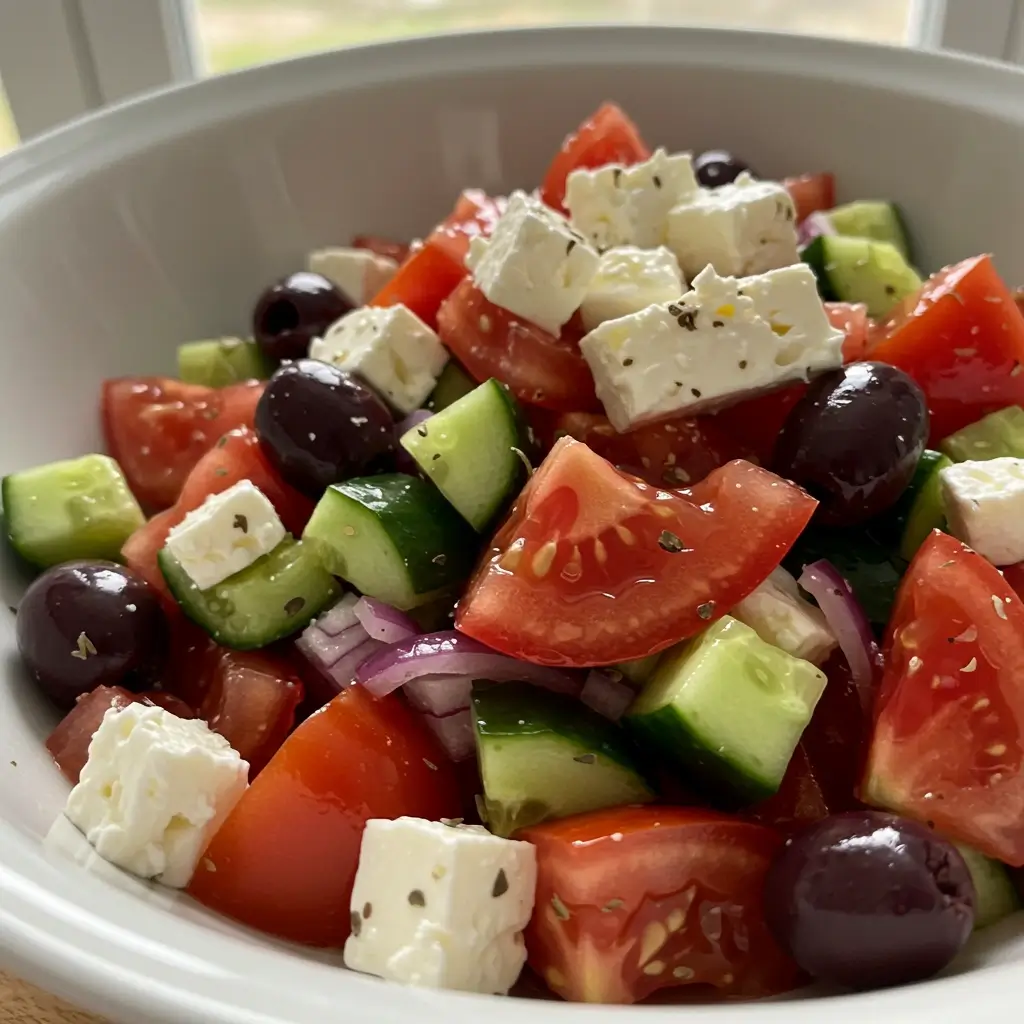Introduction
Greek Vegetable Salad is a staple in Mediterranean cuisine, offering a vibrant and refreshing dish packed with nutrients and flavors. This salad is not only a feast for the eyes but also a delight for the taste buds, combining fresh vegetables, tangy olives, and creamy feta cheese. Perfect for a quick lunch, a light dinner, or as a side dish to complement your main course, this salad is versatile and easy to prepare. In this article, we will explore the art of making a classic Greek Vegetable Salad, delve into its nutritional benefits, and provide tips for serving and enhancing your salad experience.
Ingredients
To create the perfect Greek Vegetable Salad, you will need the following ingredients:
- 1 cucumber, diced
- 2 tomatoes, chopped
- 1 bell pepper, diced
- 1 small red onion, thinly sliced
- 1 cup Kalamata olives
- 1/2 cup feta cheese, crumbled
- 3 tbsp olive oil
- 2 tbsp red wine vinegar or lemon juice
- Salt and pepper to taste
- Oregano (optional)
Instructions
Preparing the Greek Vegetable Salad is a breeze with these simple steps:
- Combine Vegetables and Olives:
In a large bowl, add the diced cucumber, chopped tomatoes, diced bell pepper, thinly sliced red onion, and Kalamata olives. Mix them gently to combine. - Dress the Salad:
Drizzle the vegetables with olive oil and red wine vinegar or lemon juice. This dressing will enhance the flavors of the fresh ingredients. - Season the Salad:
Add salt, pepper, and oregano if desired. Toss the salad gently to ensure the seasoning is evenly distributed. - Add Feta Cheese:
Top the salad with crumbled feta cheese. This creamy and tangy cheese adds a delightful contrast to the crisp vegetables. - Serve:
Serve immediately to enjoy the freshest flavors. This salad is best enjoyed cold.
Nutrition Facts
Eating healthy doesn’t mean sacrificing taste. This Greek Vegetable Salad is not only delicious but also nutritious. Here’s a breakdown of the nutritional content per serving:
- Calories: 150
- Protein: 5g
- Carbohydrates: 10g
- Fat: 12g
- Fiber: 3g
This salad is a perfect choice for those looking to maintain a balanced diet while enjoying their meals.
How to Serve
The Greek Vegetable Salad is not only a colorful and nutritious dish but also a culinary chameleon, adapting beautifully to various meal contexts. Below are several ways to serve this delightful salad, ensuring it can be enjoyed in numerous settings and occasions.
As a Main Course:
Transform your Greek Vegetable Salad into a satisfying main course, particularly appealing during warm summer months when lighter fare is preferred. To enhance its heartiness, consider adding protein-rich elements such as chickpeas, grilled shrimp, or marinated tofu. These additions not only elevate the protein content but also complement the salad’s fresh flavors. Serve it chilled on a bed of crisp lettuce or alongside a slice of crusty whole-grain bread to round out the meal. For an extra touch, drizzle some extra virgin olive oil and a squeeze of fresh lemon juice over the top just before serving, which will enhance the salad’s vibrant flavors and provide an added layer of freshness.
As a Side Dish:
The Greek Vegetable Salad shines as a side dish, perfectly balancing richer main courses. It pairs exceptionally well with Mediterranean-inspired proteins such as grilled chicken, fish, or lamb. The salad’s zesty dressing and crunchy vegetables provide a refreshing contrast to the savory, charred flavors of grilled meats. For an impressive presentation, serve the salad in a large bowl in the center of the table, encouraging guests to help themselves. For added flair, consider garnishing the salad with fresh herbs like dill or parsley, or even crumbled feta cheese, to tie in the flavors of the main dish.
In a Wrap or Sandwich:
For a quick and convenient meal option, the Greek Vegetable Salad can be easily transformed into a filling for wraps or sandwiches. Use whole grain or pita bread as a base, and layer the salad alongside additional ingredients such as hummus, sliced avocado, or roasted red peppers. This not only adds flavor but also provides a creamy texture that complements the crisp vegetables. Wrap it tightly and slice it in half for easy handling. These wraps are perfect for lunchboxes, road trips, or busy days when you need a nutritious meal on the go. For an even more indulgent version, consider adding a spread of tzatziki sauce, which enhances the Mediterranean flair and provides a refreshing contrast to the salad’s robust flavors.
At a Picnic or Potluck:
If you’re looking for a dish that travels well, the Greek Vegetable Salad is an excellent option for picnics, potlucks, or barbecues. Its robust ingredients hold up well, and it can be made in advance, allowing the flavors to meld beautifully overnight. To prepare for transport, pack the salad in a large, airtight container to maintain freshness. If you’re concerned about sogginess, keep the dressing separate and mix it in just before serving. This ensures that the vegetables remain crisp and vibrant. For added convenience, consider bringing along some serving utensils and disposable plates, making it easy for guests to help themselves. Personalize the presentation by garnishing the salad with a sprinkle of olives or a handful of nuts for a touch of elegance that will impress fellow picnic-goers.
In all these serving styles, the Greek Vegetable Salad proves to be a versatile dish that not only nourishes but also delights the palate, making it a staple for any meal occasion. Whether enjoyed solo or as part of a larger spread, this salad is sure to become a favorite in your culinary repertoire.
Additional Tips for Perfecting Your Greek Vegetable Salad
To make the most out of your Greek Vegetable Salad, consider these additional tips that can enhance your preparation and overall enjoyment of this vibrant dish:
Choose Fresh Ingredients
The foundation of a delicious Greek Vegetable Salad lies in the freshness of its ingredients. When selecting vegetables, opt for organic or locally sourced produce whenever possible, as these tend to have superior flavor and nutritional value. Look for vibrant colors and firm textures; for example, tomatoes should be plump and juicy, cucumbers should be crisp, and bell peppers should be bright and unblemished. Additionally, consider incorporating seasonal vegetables, as they are often at their peak in terms of flavor and cost-effectiveness. A mix of different textures—crunchy cucumbers, juicy tomatoes, and creamy feta—will create a more satisfying eating experience.
Experiment with Add-ins
While the classic Greek Vegetable Salad includes staple ingredients like cucumbers, tomatoes, red onions, and olives, feel free to get creative with add-ins to elevate the dish. Capers can introduce a briny tang that complements the salad beautifully, while marinated artichokes can add a unique flavor profile and a delightful chewiness. Roasted red peppers introduce a sweet, smoky element that brightens the dish. You might also consider adding ingredients like avocado for creaminess, chickpeas for protein, or even grains like quinoa or farro for added texture and nutrition. Mixing in fresh herbs such as parsley, dill, or mint can also enhance the salad’s flavor and provide a refreshing twist.
Customize the Dressing
The dressing is a crucial component of your Greek Vegetable Salad, and customizing it allows you to tailor the dish to your personal preferences. The traditional dressing typically consists of olive oil, red wine vinegar, lemon juice, and oregano. For those who prefer a bolder flavor, consider adding minced garlic or Dijon mustard to the mix. If you enjoy a tangy kick, increasing the amount of lemon juice or even incorporating a bit of balsamic vinegar can make a significant difference. For those with a sweet tooth, a drizzle of honey or agave syrup can balance out the acidity and enhance the overall flavor profile. Don’t be afraid to whisk in some Greek yogurt for a creamier texture or sprinkle in some feta cheese to enhance the salty, tangy notes of the dressing.
Make It Ahead
While Greek Vegetable Salad is best enjoyed fresh, with a bit of planning, you can prepare it in advance to save time during busy days or gatherings. To maintain the salad’s crispness and flavor, chop the vegetables and store them in an airtight container in the refrigerator. Similarly, you can prepare the dressing in advance and keep it in a separate jar. This approach prevents the vegetables from becoming soggy. Just before serving, toss the vegetables with the dressing to ensure they are evenly coated and fresh. For an added touch, consider allowing the salad to sit for a few minutes after mixing; this will allow the flavors to meld together beautifully without compromising the crispness of the ingredients.
Incorporate Seasonal Variations
Another way to enhance your Greek Vegetable Salad is by incorporating seasonal variations. In the summer, add fresh corn or zucchini for a sweet crunch, while in the fall, consider roasted butternut squash for a touch of sweetness and warmth. During the winter months, you can include hearty root vegetables like carrots or beets, which can be roasted for added depth of flavor. This not only enriches the salad’s taste but also keeps it interesting throughout the year.
Serve with Complementary Dishes
To elevate your dining experience, consider pairing your Greek Vegetable Salad with complementary dishes. It serves as a perfect side for grilled meats, seafood, or even as a light main course alongside pita bread and tzatziki sauce. By serving it with a selection of Mediterranean-inspired dishes, you can create a vibrant and balanced meal that highlights the freshness of the salad while offering a variety of textures and flavors.
By incorporating these additional tips into your preparation, you can transform your Greek Vegetable Salad into a delightful and versatile dish that tantalizes the taste buds, celebrates freshness, and satisfies any gathering or personal craving. Consider adding a protein like grilled chicken, chickpeas, or even shrimp to turn it into a more substantial meal. Experiment with different herbs, such as fresh oregano or mint, to add unique layers of flavor. You can also play around with textures by adding a crunchy element like toasted pine nuts or sunflower seeds for extra dimension.
The beauty of this salad lies in its adaptability—you can tailor it to fit various dietary preferences or what you have available in your kitchen. Whether you prefer a tangier dressing, extra feta, or a bit of a spicy kick with some red pepper flakes, these small adjustments allow you to make the salad truly your own. Enjoying the process of making and sharing this salad can be as fulfilling as savoring its delicious flavors! It’s a dish that not only brings people together but also offers a healthy, satisfying option that works perfectly for any occasion.
FAQs
1. Can I use different types of olives?
Absolutely! While Kalamata olives are traditional, you can use any olives you prefer or have on hand.
2. Is there a vegan version of this salad?
Yes, simply omit the feta cheese or replace it with a vegan cheese alternative.
3. How long can I store the salad?
The salad is best consumed within a day of preparation to enjoy its freshness, but it can be stored in the refrigerator for up to two days.
4. Can I add protein to this salad?
Certainly! Grilled chicken, shrimp, or chickpeas can be added for extra protein.
5. What is the best way to slice the onions thinly?
Use a sharp knife or a mandoline slicer for evenly thin onion slices.
Conclusion
The Greek Vegetable Salad is a celebration of fresh flavors and healthy ingredients. With its ease of preparation and versatility, it’s a dish that can be enjoyed by everyone, whether you’re a seasoned cook or a kitchen novice. The combination of crisp cucumbers, juicy tomatoes, red onions, and Kalamata olives offers a refreshing and vibrant base, while the crumbled feta cheese adds a creamy richness that perfectly balances the other ingredients. The zesty dressing, made with olive oil, lemon juice, and herbs, ties everything together for a satisfying and flavorful experience.
By following the instructions and utilizing the tips provided, you can create a delicious and satisfying salad that will become a staple in your culinary repertoire. You can easily customize it to suit your preferences, adding or removing ingredients based on what you have on hand. Whether served as a main course, paired with grilled chicken or lamb, or as a side dish to complement any meal, this salad is sure to impress with its vibrant colors and delightful taste. Embrace the flavors of the Mediterranean and delight your taste buds with this classic Greek Vegetable Salad. Enjoy! It’s the perfect addition to any meal, bringing a touch of freshness and flair to your dining table.
Print
Greek Vegetable Salad Recipe
Ingredients
- 1 cucumber, diced
- 2 tomatoes, chopped
- 1 bell pepper, diced
- 1 small red onion, thinly sliced
- 1 cup Kalamata olives
- 1/2 cup feta cheese, crumbled
- 3 tbsp olive oil
- 2 tbsp red wine vinegar or lemon juice
- Salt and pepper to taste
- Oregano (optional)
Instructions
- Combine Vegetables and Olives:
In a large bowl, add the diced cucumber, chopped tomatoes, diced bell pepper, thinly sliced red onion, and Kalamata olives. Mix them gently to combine. - Dress the Salad:
Drizzle the vegetables with olive oil and red wine vinegar or lemon juice. This dressing will enhance the flavors of the fresh ingredients. - Season the Salad:
Add salt, pepper, and oregano if desired. Toss the salad gently to ensure the seasoning is evenly distributed. - Add Feta Cheese:
Top the salad with crumbled feta cheese. This creamy and tangy cheese adds a delightful contrast to the crisp vegetables. - Serve:
Serve immediately to enjoy the freshest flavors. This salad is best enjoyed cold.
Nutrition
- Serving Size: One Normal Portion
- Calories: 150
- Fat: 12g
- Carbohydrates: 10g
- Fiber: 3g
- Protein: 5g





